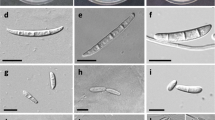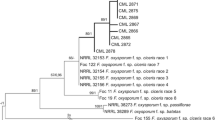Abstract
Thirty-six isolates of Fusarium oxysporum originated from Eruca vesicaria and Diplotaxis tenuifolia together with eight reference strains belonging to the formae speciales raphani, matthioli and conglutinans, typical on the Brassicaceae family, were tested for pathogenicity on two species of rocket plants (E. vesicaria L., syn. E. sativa, cv. ‘Rucola coltivata’; and D. tenuifolia cv. ‘Winter’) cultivated in the glasshouse. The results showed that different isolates were slightly, moderately or highly virulent. The strains were examined for differences in the nucleotide sequence of the ribosomal DNA (rDNA) intergenic spacer (IGS) region, about 2.5 kb long. The phylogenetic (neighbor-joining) analysis performed on the isolates enabled identification of four different groups, named I, II, III and IV. Thirty-one isolates out of 36 clustered in group I and were genetically similar to F. oxysporum f.sp. raphani. By considering the pathogenicity of the strains included in Group I, a partial host specialization could be observed: the average disease index of the isolates from D. tenuifolia was higher on wild rocket, whereas the average disease index of the isolates from E. vesicaria was higher on cultivated rocket. Moreover, isolates from cultivated rocket showed, on average, a higher degree of aggressiveness than the isolates from wild rocket. Concerning Group I, the sequence analysis confirmed the homogeneity of the population, with only five parsimony-informative SNPs and five haplotypes. Twenty-six out of 31 isolates belonged to haplotype 1. Groups II and III were genetically similar to strains of F. oxysporum f.sp. matthioli. Three other strains, not pathogenic or with a medium level of virulence, clustered together in Group 4, but their sequence was distant from that of other formae speciales. The pathogenicity and IGS analysis confirmed the presence of virulence variation and genetic diversity among the F. oxysporum isolates studied. To our knowledge, this is the first report of differentiation of formae speciales of F. oxysporum on rocket plants by IGS analysis.

Similar content being viewed by others
References
Alves-Santos, F. M., Benito, E. P., Eslava, A. P., & Diazminguez, J. M. (1999). Genetic diversity of Fusarium oxysporum strains from common bean fields in Spain. Applied and Environmental Microbiology, 65, 3335–3340.
Amatulli, M. T., Spadaro, D., Gullino, M. L., & Garibaldi, A. (2010). Molecular identification of Fusarium spp. associated with bakanae disease of rice and assessment of their virulence. Plant Pathology, 59, 839–844.
Appel, D. J., & Gordon, T. R. (1995). Intra-specific variation within populations of Fusarium oxysporum based on RFLP analysis of the intergenic spacer region of the rDNA. Experimental Mycology, 19, 120–128.
Appel, D. J., & Gordon, T. R. (1996). Relationships among pathogenic and non-pathogenic isolates of Fusarium oxysporum based on the partial sequences of the intergenic spacer region of the ribosomal DNA. Molecular Plant-Microbe Interaction, 9, 125–138.
Catti, A., Pasquali, M., Ghiringhelli, D., Garibaldi, A., & Gullino, M. L. (2007). Analysis of vegetative compatibility groups of Fusarium oxysporum from Eruca vesicaria and Diplotaxis tenuifolia. Journal of Phytopathology, 155, 61–64.
Chatterjee, C., & Rai, J. N. (1974). Fusarium wilt of Eruca vesicaria—observation on comparative pathogenicity of some strains of Fusarium oxysporum. Indian Phytopathology, 28, 309–311.
Dissanayake, M. L. M. C., Kashima, R., Tanaka, S., & Ito, S. I. (2009). Genetic diversity and pathogenicity of Fusarium oxysporum isolated from wilted Welsh onion in Japan. Journal of General Plant Pathology, 75, 125–130.
Edel, V., Steinberg, C., Avelange, I., Laguerre, G., & Alabouvette, C. (1995). Comparison of three molecular methods for the characterisation of Fusarium oxysporum strains. Phytopathology, 85, 579–585.
Engelbrecht, C. J. B., Harrington, T. C., Alfenas, A. C., & Suarez, C. (2007). Genetic variation in populations of the cacao wilt pathogen, Ceratocystis cacaofunesta. Plant Pathology, 56, 923–933.
Enya, J., Togawa, M., Takeuchi, T., Yoshida, S., Tsushima, S., Arie, T., et al. (2008). Biological and phylogenetic characterization of Fusarium oxysporum complex, which causes yellows on Brassica spp. and proposal of F. oxysporum f. sp. rapae, a novel forma specialis pathogenic on B. rapa in Japan. Phytopathology, 98, 475–483.
Fourie, G., Steenkamp, E. T., Gordon, T. R., & Viljoen, A. (2009). Evolutionary relationships among the Fusarium oxysporum f. sp. cubense vegetative compatibility groups. Applied and Environmental Microbiology, 75, 4770–4781.
Fravel, D., Olivain, C., & Alabouvette, C. (2003). Fusarium oxysporum and its biocontrol. New Phytologist, 157, 4770–4781.
Fuchs, J. G., Moënne-Loccoz, Y., & Défago, G. (1997). Non-pathogenic Fusarium oxysporum strain Fo47 induces resistance to Fusarium wilt in tomato. Plant Disease, 81, 492–496.
Fujinaga, M., Ogiso, H., Shinohara, H., Tsushima, S., Nishimura, N., Togawa, M., et al. (2005). Phylogenetic relationships between the lettuce root rot pathogen Fusarium oxysporum f. sp. lactucae races 1, 2 and 3 based on the sequence of the intergenic spacer region of its ribosomal DNA. Journal of General Plant Pathology, 71, 402–407.
Garibaldi, A., Gilardi, G., & Gullino, M. L. (2002). First report of Fusarium oxysporum on lettuce in Europe. Plant Disease, 86, 1052.
Garibaldi, A., Gilardi, G., & Gullino, M. L. (2003). First report of Fusarium oxysporum on Eruca vesicaria and Diplotaxis sp. in Europe. Plant Disease, 87, 201.
Garibaldi, A., Gilardi, G., & Gullino, M. L. (2004). First report of Fusarium oxysporum causing vascular wilt of lamb’s lettuce (Valerianella olitoria) in Italy. Plant Disease, 88, 83.
Garibaldi, A., Gilardi, G., & Gullino, M. L. (2006). Evidence for an expanded host range of Fusarium oxysporum f. sp. raphani. Phytoparasitica, 34, 115–121.
Gilardi, G., Sendhilvel, V., Garibaldi, A., & Gullino, M. L. (2008). Lamb’s lettuce (Valerianella olitoria): new host of Fusarium oxysporum f. sp. conglutinans. Journal of Plant Diseases and Protection, 115, 229–233.
Gupta, A. K. (1988). Fusarium wilt of taramira—a new record for Rajasthan. Indian Journal of Mycology and Plant Pathology, 172, 239–240.
Hanahan, D. (1983). Studies on transformation of Escherichia coli with plasmids. Journal of Molecular Biology, 166, 557–580.
Harrington, T. C., Steimel, J., Workneh, F., & Yang, X. B. (2003). Characterization of two races of Phialophora gregata in North-Central United States. Phytopathology, 93, 901–912.
Harrington, T. C., Thorpe, D. J., & Alfenas, A. C. (2011). Genetic variation in aggressiveness to native and exotic hosts among Brazilian populations of Ceratocystis fimbriata. Phytopathology, 101, 555–566.
Katan, T. (1999). Current status of vegetability groups in Fusarium oxysporum. Phytoparasitica, 27, 51–64.
Kawabe, M., Katsube, K., Yoshida, T., Arie, T., & Tsuchiya, K. (2007). Genetic diversity of Fusarium oxysporum f. sp. spinaciae in Japan based on phylogenetic analyses of rDNA-IGS and MAT1 sequences. Journal of General Plant Pathology, 73, 353–359.
Kawabe, M., Kobayashi, Y., Okada, G., Yamaguchi, I., Teraoka, T., & Arie, T. (2005). Three evolutionary lineages of tomato wilt pathogen, Fusarium oxysporum f. sp. lycopersici, based on sequences of IGS, MAT1 and pg1, are each composed of isolates of a single mating type and a single or closely related vegetative compatibility group. Journal of General Plant Pathology, 71, 263–272.
Kimura, M. A. (1980). Simple method for estimating evolutionary rates of base substitutions through comparative studies of nucleotide sequences. Journal of Molecular Evolution, 16, 111–120.
Komada, H. (1975). Development of a selective medium for quantitative isolation of Fusarium oxysporum from natural soil. Review of Plant Protection Research, 8, 114–125.
Larkin, R. P., Hopkins, D. L., & Martin, F. N. (1996). Suppression of Fusarium wilt of watermelon by non-pathogenic Fusarium oxysporum and other microorganisms recovered from a disease-suppressive soil. Phytopathology, 86, 812–819.
Lievens, B., Rep, M., & Thomma, B. P. H. J. (2008). Recent developments in the molecular discrimination of formae speciales of Fusarium oxysporum. Pest Management Science, 64, 781–788.
Ma, L. J., van der Does, H. C., Borkovich, K. A., Coleman, J. J., Daboussi, M. J., Pietro, A. D., et al. (2010). Comparative genomics reveals mobile pathogenicity chromosomes in Fusarium. Nature, 464, 367–373.
Mbofung, G. Y., Hong, S. G., & Pryor, B. M. (2007). Phylogeny of Fusarium oxysporum f. sp. lactucae inferred from mitochondrial small subunit, elongation factor 1-α and nuclear ribosomal intergenic spacer sequence data. Phytopathology, 97, 87–98.
Minerdi, D., Moretti, M., Gilardi, G., Barberio, C., Gullino, M. L., & Garibaldi, A. (2008). Bacterial ectosymbionts and virulence silencing in a Fusarium oxysporum strain. Environmental Microbiology, 10, 1725–1741.
Namiki, F., Shiomi, T., Kayamura, T., & Tsuge, T. (1994). Characterization of the formae speciales of Fusarium oxysporum causing wilts of cucurbits by DNA fingerprinting with nuclear repetitive DNA sequences. Applied and Environmental Microbiology, 60, 2684–2691.
O’Donnell, K., Gueidan, C., Sink, S., Johnston, P. R., Crous, P. W., Glenn, A., et al. (2009). A two-locus DNA sequence database for typing plant and human pathogens within Fusarium oxysporum species complex. Fungal Genetics and Biology, 46, 936–948.
Olivain, C., Humbert, C., Nahalkova, J., Fatehi, J., L’Haridon, F. L., & Alabouvette, C. (2006). Colonization of tomato root by pathogenic and non-pathogenic Fusarium oxysporum strains inoculated together and separately into the soil. Applied and Environmental Microbiology, 72, 1523–1531.
Padulosi, S., & Pignone, D. [Eds.] (1997). Rocket: A Mediterranean crop for the world. Report of a Workshop, 1996, Legnano, Italy. Rome, Italy: International Plant Genetic Resources Institute.
Pariaud, B., Ravigne, V., Halkett, F., Goyeau, H., Carlier, J., & Lannou, C. (2009). Aggressiveness and its role in the adaptation of plant pathogens. Plant Pathology, 58, 409–424.
Pasquali, M., Saravanakumar, D., Gullino, M. L., & Garibaldi, A. (2008). Sequence-specific amplified polymorphism (SSAP) technique to analyse Fusarium oxysporum f. sp. lactucae VCG 0300 isolate from lettuce. Journal of Plant Pathology, 90, 527–535.
Saitou, N., & Nei, M. (1987). The neighbour-joining method: a new method for reconstructing phylogenetic trees. Molecular Biology and Evolution, 4, 406–425.
Santamaria, P., Elia, A., & Serio, F. (2002). Effect of solution nitrogen concentration on yield, leaf element content and water and nitrogen use efficiency of three hydroponically grown rocket salad genotypes. Journal of Plant Nutrition, 25, 245–258.
Spadaro, D., & Gullino, M. L. (2005). Improving the efficacy of biocontrol agents against soilborne pathogens. Crop Protection, 24, 601–613.
Srinivasan, K., Gilardi, G., Spadaro, D., Garibaldi, A., & Gullino, M. L. (2010). Molecular characterization through IGS sequencing of formae speciales of Fusarium oxysporum pathogenic on lamb’s lettuce. Phytopathologia Mediterranea, 49, 309–320.
Tamura, K., Dudley, J., Nei, M., & Kumar, S. (2007). MEGA4: Molecular Evolutionary Genetics Analysis (MEGA) software, version 40. Molecular Biology and Evolution, 24, 1596–1599.
Taylor, J. W., Jacobson, D. J., Kroken, S., Kasuga, T., Geiser, D. M., Hibbett, D. S., et al. (2000). Phylogenetic species recognition and species concepts in fungi. Fungal Genetics and Biology, 31, 21–32.
Thiel, T., Kota, R., Grosse, I., Stein, N., & Graner, A. (2004). SNP2CAPS: a SNP and INDEL analysis tool for CAPS marker development. Nucleic Acids Research, 32, e1–e5.
Thompson, J. D., Higgins, D. C., & Gibson, T. J. (1994). CLUSTAL W: improving the sensitivity of progressive multiple sequence alignment through sequence weighting, position specific gap penalties and weight matrix choice. Nucleic Acids Research, 22, 4673–4680.
van der Does, H. C., Lievens, L., Claes, L., Houterman, P. M., Cornelissen, B. J. C., & Rep, M. (2008). The presence of a virulence locus discriminates Fusarium oxysporum isolates causing tomato wilt from other isolates. Environmental Microbiology, 10, 1475–1485.
Woo, S. L., Zoina, A., Del Sorbo, G., Lorito, M., Nanni, B., Scala, F., et al. (1996). Characterisation of Fusarium oxysporum f. sp. phaseoli by pathogenic races, VCG, RFLP and RAPD. Phytopathology, 86, 966–973.
Acknowledgments
We gratefully acknowledge the financial support from the projects “Advanced Diagnostic Tools, Disease Detection Networking and Technical Extension (ADVANET) for non-conventional disease control strategies in vegetable production in Piedmont” and “Safe Food Control Development of innovative systems and technologies for the production, storage, processing and valorization of Piedmontese fruit and vegetables” funded by the Piedmont Region. We are especially grateful to Dr. Robert Milne, who recently passed away, for his last accurate revision of manuscripts of our research group.
Author information
Authors and Affiliations
Corresponding author
Rights and permissions
About this article
Cite this article
Srinivasan, K., Spadaro, D., Poli, A. et al. Genetic diversity and pathogenicity of Fusarium oxysporum isolated from wilted rocket plants in Italy. Phytoparasitica 40, 157–170 (2012). https://doi.org/10.1007/s12600-011-0207-z
Received:
Accepted:
Published:
Issue Date:
DOI: https://doi.org/10.1007/s12600-011-0207-z




